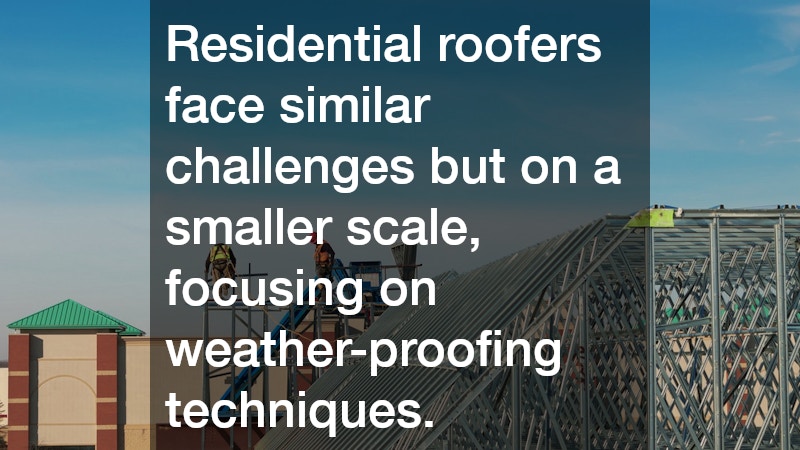In the roofing industry, understanding the differences between commercial and residential roofing is crucial. Whether you’re a homeowner considering a new roof or a business owner evaluating your options, knowing the distinctions can help you make informed decisions. This article explores the three key differences between commercial and residential roofers that are commonly inquired about.
What are the Different Skill Sets Required for Commercial vs Residential Roofers?
Experience and Training
Commercial roofers typically undergo more specialized training due to the complexity of projects. This often requires certification in specific roofing systems, ensuring that they are well-versed in technical aspects unique to large-scale buildings.
Additionally, these professionals are adept at handling different architectural challenges and complex building layouts.
Residential roofers are generally skilled in a wide range of materials and styles suitable for homes. Their training focuses on aesthetic considerations and practical applications that fit residential needs, such as energy efficiency. They usually possess a diverse toolkit of skills for working with different types of residential roofing materials like asphalt shingles, tiles, and metal roofs.
Both types of roofers are skilled, but the scope and focus of their expertise differ significantly. Commercial roofers might specialize in flat or low-slope roofs typical of industrial and commercial buildings. In contrast, residential roofers are adept at handling varied roof pitches and artistic styles favored in home construction.
Tools and Techniques
There are significant differences in the equipment used by commercial versus residential roofers. Commercial roofers might utilize heavier machinery and advanced technologies to manage the extensive surface areas typical of commercial buildings. This often includes cranes, hoists, and other large-scale equipment to facilitate the movement and application of roofing materials.
Residential roofers often use simpler, manual tools designed for detailed work. Their toolkits typically include nail guns, shingle cutters, and smaller conveyors suitable for navigating the varied angles and pitches of residential roofs. The emphasis is on precision and finesse to ensure the finished product complements the home’s aesthetic appeal.
Advancements in technology have introduced specialized tools in both sectors, enhancing efficiency and safety. For example, thermal imaging cameras are now commonly used in both commercial and residential roofing to identify insulation issues. These tools support roofers in providing quality service, tailored to the specific demands of each type of roofing project.
How Does the Scale of Projects Impact Commercial and Residential Roofers?
Project Management
Larger commercial projects typically demand more extensive project management skills compared to residential projects. This includes coordinating with multiple stakeholders, such as architects, contractors, and business owners, while adhering to strict timelines.
Residential projects, while generally smaller in scale, still require effective project management to ensure timely completion and client satisfaction. The interactions are often more personalized, involving direct communication with homeowners to tailor the project to specific needs and preferences.
Timelines for commercial roofing are often dictated by factors like business operational hours and organizational deadlines. In contrast, residential roofing projects can be more flexible, occasionally rescheduled based on weather conditions or homeowner availability.
Materials and Cost
The scale differences also influence the types and volumes of materials used, with commercial projects often requiring bulk purchases. Commercial roofs are typically constructed with materials designed for durability and longevity, such as thermoplastic, rubber, and modified bitumen.
Residential roofing projects, due to their smaller scale, focus more on aesthetics and cost-effectiveness. Options such as asphalt shingles, wooden shakes, and metal roofing offer variety for homeowners looking to enhance their home’s curb appeal within a specific budget.
Material costs can significantly differ, impacting the overall project budget. In commercial roofing, material choice often prioritizes function over form, directly affecting the bottom line of the project. In contrast, residential roofing involves balancing cost with style preferences, impacting material selection and budget allocation.
What Are the Typical Challenges Faced by Commercial vs Residential Roofers?
Logistical Challenges
Commercial roofing projects often involve logistical hurdles such as working around business operations and scheduling in high-traffic areas. Time constraints are more pronounced, as delays can impact business activities and financial workflows.
Residential projects usually focus on minimizing disruptions to daily home life. Roofers must coordinate with homeowners to find convenient scheduling that accommodates family routines, school schedules, and local ordinances.
Both types of projects require logistical planning, but the context and impact of those plans differ. In commercial settings, the scale necessitates advanced organization to minimize downtime and ensure project milestones are met. Residential plans often hinge on personalized service and flexibility, with the primary aim of enhancing home life satisfaction.
Weather and Environmental Factors
Both commercial and residential roofers must consider weather impacts, but the larger surface areas and different materials used in commercial roofing can make these challenges more pronounced. Commercial roofing materials, often chosen for their reflectivity and insulation properties, can be affected by extreme temperatures and harsh climates.
Residential roofers face similar challenges but on a smaller scale, focusing on weather-proofing techniques suitable for single-family homes. The choice of shingles, coatings, and underlays can significantly influence a home’s resilience against weather adversities.
Understanding the key differences between commercial and residential roofers equips property owners with essential knowledge for making better decisions. From the skill sets required to the scale of projects and unique challenges faced, these insights provide clarity on what to expect when embarking on a commercial or residential roofing journey.

